A Performance-Based Window Design and Evaluation Model for Naturally Ventilated Offices
Abstract
:1. Introduction
1.1. Aim and Objectives of the Study
- To develop a performance-based window design model for early window design in terms of natural ventilation performance;
- To develop an evaluation model for assessing the findings of the model;
- To test the developed model using a case application;
- To identify the most influential window design parameters and their optimal levels with respect to each selected criterion;
- To demonstrate the trade-off selection method for window design variables among multiple conflicting performance criteria.
1.2. Architectural Considerations for Natural Ventilation
1.3. Window Design Parameters
2. The Proposed Model of Window Design and Evaluation Relative to Natural Ventilation Performance
2.1. Rationale of the Proposed Model
2.2. Components of the Proposed Model
2.2.1. Knowledge Acquisition
2.2.2. Establishing a Relationship between Window Design and Natural Ventilation
2.2.3. Design of Experiments and Identifying Performance Criteria
2.2.4. Performance-Based Dynamic Simulations
2.2.5. Evaluation and Decision-Making
2.3. Evaluation Method of the Findings
2.3.1. Assessment of Indoor Air Performance
2.3.2. Assessment of Ventilation Rates
2.3.3. Assessment of Indoor Thermal Comfort
2.3.4. Assessment of Heating, Ventilation, and Airconditioning Loads
2.4. Validation of the Model Using Ventilative Cooling Methods
3. Model Application: Window Design of a Single Office with Single-Sided Natural Ventilation
3.1. Knowledge Acquisition
3.2. Establishing a Relationship between Window Design and Natural Ventilation
3.3. DOE and Selection of Performance Criteria
3.4. Performance-Based Simulation
3.4.1. Setting Weather Data
3.4.2. Benchmark Values for Internal Heat Gains and Schedules
4. Results and Discussion
4.1. Impact of Window Design Variables on the Studied Performance Criteria
4.2. Identifying Optimal Design Alternative
- Larger window size (more opening area) (i.e., 50% WFR);
- South orientation;
- Casement or double-hung windows;
- Double glass with low-E coating;
- Longitudinal windows (i.e., an aspect ratio of 1:2) rather than square windows;
- Window located in the middle of the wall;
- No shading devices because external shadings may prevent wind from entering the space.
- Large-sized window (i.e., 50% WFR), noting that 20% WFR performs better than 30% WFR;
- Southern window orientation offers far better thermal comfort acceptance compared to other orientations;
- Double-hung or sliding window types;
- Triple glass or low-E coated double glass;
- Square windows (i.e., an aspect ratio of 1:1);
- Window located in one side of the wall rather than the middle; however, this variable does not make a considerable difference in adaptive comfort;
- The availability of solar shading contributes to better indoor thermal conditions, especially in the case of higher-glazing U-values.
- Small to medium window size (e.g., 10% WFR to 20% WFR);
- Northern orientation or southern orientation;
- Sliding or casement;
- Triple glass, followed by double glass with low-E coating;
- Square windows;
- Window located in the middle of the wall;
- The presence of an external shading device.
4.3. Trade-off Selection Based on Near-Optimal Level Combinations
4.4. Results of Airflow Rates
4.5. Results of Carbon Dioxide Concentration
4.6. Results of Adaptive Thermal Comfort
4.7. Air Conditioning Loads of the Mixed-Mode Strategy and a Fully Airconditioned Case
5. Conclusions
5.1. Contribution of Window Design Parameters to Airflow Rate and CO2 Concentration
- Window size was in the first rank or scored the highest percentage of contribution (81.59% and 73.54%, respectively), followed by window orientation and type.
5.2. Contribution of Window Design Parameters to Adaptive Thermal Comfort
- Window orientation plays a vital role in providing comfortable indoor conditions, with a percentage of contribution of 58.12%. Window orientation is significantly correlated with the position of the sun and the direction of the wind, determining the amount of air and solar radiation permitted into the space.
5.3. Contribution of Window Design Parameters to the Supplementary Air Conditioning Loads
- The supplementary AC load required to retain indoor thermal conditions when NV is not sufficient is highly influenced by the window’s glazing property (or U-value), for which the percentage of contribution was recorded at 29.36%.
- Window orientation, size, type, and external shading are the most significant parameters affecting the energy-efficient MM office, with their individual factor effectiveness calculated as 26.52%, 14.79%, 11.44%, and 8.09%, respectively.
Author Contributions
Funding
Institutional Review Board Statement
Informed Consent Statement
Data Availability Statement
Conflicts of Interest
References
- DeDear, R.J.; Brager, G.S. Thermal Comfort in Naturally Ventilated Buildings: Revisions to ASHRAE Standard 55. Energy Build. 2002, 34, 549–561. [Google Scholar] [CrossRef] [Green Version]
- Fang, L.; Wargocki, P.; Witterseh, T.; Clausen, G.; Fanger, P.O. Field Study on the Impact of Temperature, Humidity and Ventilation on Perceived Air Quality. In Proceedings of the Indoor Air, Edinburgh, Scotland, 8–13 August 1999; pp. 107–112. [Google Scholar]
- Jia, L.-R.; Han, J.; Chen, X.; Li, Q.-Y.; Lee, C.-C.; Fung, Y.-H. Interaction between Thermal Comfort, Indoor Air Quality and Ventilation Energy Consumption of Educational Buildings: A Comprehensive Review. Buildings 2021, 11, 591. [Google Scholar] [CrossRef]
- Larsen, T.S.; Heiselberg, P. Single-Sided Natural Ventilation Driven by Wind Pressure and Temperature Difference. Energy Build. 2008, 40, 1031–1040. [Google Scholar] [CrossRef]
- Abdullah, H.K.; Alibaba, H.Z. Towards Nearly Zero-Energy Buildings: The Potential of Photovoltaic-Integrated Shading Devices To Achieve Autonomous Solar Electricity and Acceptable Thermal Comfort in Naturally-Ventilated Office Spaces. In Proceedings of the 16th International Conference on Clean Energy, Philadelphia, PA, USA, 9–11 May 2018; Eastern Mediterranean University: Famagusta, North Cyprus, 2018; pp. 1–11. [Google Scholar]
- Mora-pérez, M.; Guillen-guillamón, I.; López-patiño, G.; López-jiménez, P.A. Natural Ventilation Building Design Approach in Mediterranean Regions—A Case Study at the Valencian Coastal Regional Scale (Spain). Sustainability 2016, 8, 855. [Google Scholar] [CrossRef] [Green Version]
- Duan, Z.; Sun, Y.; Wang, M.; Hu, R.; Dong, X. Evaluation of Mixed-Mode Ventilation Thermal Performance and Energy Saving Potential from Retrofitting a Beijing Office Building. Buildings 2022, 12, 793. [Google Scholar] [CrossRef]
- Zhai, Z.; El Mankibi, M.; Zoubir, A. Review of Natural Ventilation Models. Energy Procedia 2015, 78, 2700–2705. [Google Scholar] [CrossRef] [Green Version]
- Kleiven, T. Natural Ventilation in Buildings: Architectural Concepts, Consequences and Possibilities; Norwegian University of Science and Technology: Trondheim, Norway, 2003. [Google Scholar]
- Tran, T. Optimization of Natural Ventilation Design in Hot and Humid Climates Using Building Energy Simulation; University of Hawai’i: Honolulu, HI, USA, 2013. [Google Scholar]
- Inanici, M.N.; Demirbilek, F.N. Thermal Performance Optimization of Building Aspect Ratio and South Window Size in Five Cities Having Different Climatic Characteristics of Turkey. Build. Environ. 2000, 35, 41–52. [Google Scholar] [CrossRef]
- Elshafei, G.; Negm, A.; Bady, M.; Suzuki, M.; Ibrahim, M.G. Numerical and Experimental Investigations of the Impacts of Window Parameters on Indoor Natural Ventilation in a Residential Building. Energy Build. 2017, 141, 321–332. [Google Scholar] [CrossRef]
- Shetabivash, H. Investigation of Opening Position and Shape on the Natural Cross Ventilation. Energy Build. 2015, 93, 1–15. [Google Scholar] [CrossRef]
- Stavrakakis, G.M.; Zervas, P.L.; Sarimveis, H.; Markatos, N.C. Optimization of Window-Openings Design for Thermal Comfort in Naturally Ventilated Buildings. Appl. Math. Model. 2012, 36, 193–211. [Google Scholar] [CrossRef]
- Yin, W.; Zhang, G.; Yang, W.; Wang, X. Natural Ventilation Potential Model Considering Solution Multiplicity, Window Opening Percentage, Air Velocity and Humidity in China. Build. Environ. 2010, 45, 338–344. [Google Scholar] [CrossRef]
- Gao, C.F.; Lee, W.L. Evaluating the Influence of Openings Configuration on Natural Ventilation Performance of Residential Units in Hong Kong. Build. Environ. 2011, 46, 961–969. [Google Scholar] [CrossRef]
- Roetzel, A.; Tsangrassoulis, A.; Dietrich, U.; Busching, S. A Review of Occupant Control on Natural Ventilation. Renew. Sustain. Energy Rev. 2010, 14, 1001–1013. [Google Scholar] [CrossRef]
- Albatayneh, A. Optimising the Parameters of a Building Envelope in the East Mediterranean Saharan, Cool Climate Zone. Buildings 2021, 11, 43. [Google Scholar] [CrossRef]
- Fadzil, S.F.S.; Abdullah, A.; Harun, W.M.W. The Impact of Varied Orientation and Wall Window Ratio (WWR) To Daylight Distribution in Residental Rooms. In Proceedings of the CIBW 107 International Symposium on Construction in Developing Economies: Commonalities Among Diversities, Penang, Malaysia, 5–7 October 2009; pp. 478–486. [Google Scholar]
- Wagdy, A.; Sherif, A.; Sabry, H.; Arafa, R.; Mashaly, I. Daylighting Simulation for the Configuration of External Sun-Breakers on South Oriented Windows of Hospital Patient Rooms under a Clear Desert Sky. Sol. Energy 2017, 149, 164–175. [Google Scholar] [CrossRef]
- AlAnzi, A.; Seo, D.; Krarti, M. Impact of Building Shape on Thermal Performance of Office Buildings in Kuwait. Energy Convers. Manag. 2009, 50, 822–828. [Google Scholar] [CrossRef]
- Pedrini, A.; Vilar De Carvalho, J.P. Analysis of Daylight Performance in Classrooms in Humid and Hot Climate. In Proceedings of the 30th International PLEA Conference, Gujarat, India, 16–18 December 2014; CEPT University: Ahmedabad, India, 2014; pp. 1–10. [Google Scholar]
- Aflaki, A.; Mahyuddin, N.; Al-Cheikh Mahmoud, Z.; Baharum, M.R. A Review on Natural Ventilation Applications through Building Façade Components and Ventilation Openings in Tropical Climates. Energy Build. 2015, 101, 153–162. [Google Scholar] [CrossRef]
- Alibaba, H.Z. Determination of Optimum Window to External Wall Ratio for Offices in a Hot and Humid Climate. Sustainability 2016, 8, 187. [Google Scholar] [CrossRef] [Green Version]
- Sacht, H.; Lukiantchuki, M.A. Windows Size and the Performance of Natural Ventilation. Procedia Eng. 2017, 196, 972–979. [Google Scholar] [CrossRef]
- Huang, K.; Feng, G.; Li, H.; Yu, S. Opening Window Issue of Residential Buildings in Winter in North China: A Case Study in Shenyang. Energy Build. 2014, 84, 567–574. [Google Scholar] [CrossRef]
- Al-Tamimi, N.A.M.; Syed Fadzil, S.F.; Wan Harun, W.M. The Effects of Orientation, Ventilation, and Varied WWR on the Thermal Performance of Residential Rooms in the Tropics. J. Sustain. Dev. 2011, 4, 142. [Google Scholar] [CrossRef]
- KTMMOB Chapter 96 Regulation: The Streets and Buildings Regulation. Available online: http://www.mimarlarodasi.org/tr/mevzuat/fasil-96-duzenleme/ (accessed on 21 May 2019).
- Rilling, D.; Han Siang, S.; Hui Siang, S. Thermal Simulation as Design Tool for Residential Buildings in Southeast Asia. J. Alam Bina 2007, 9, 45–54. [Google Scholar]
- Shaeri, J.; Habibi, A.; Yaghoubi, M.; Chokhachian, A. The Optimum Window-to-Wall Ratio in Office Buildings for Hot-Humid, Hot-Dry, and Cold Climates in Iran. Environments 2019, 6, 45. [Google Scholar] [CrossRef] [Green Version]
- NAFS. AAMA/NWWDA/CSA 101/I.S.2/A440-08—North. American Fenestration Standard/Specification for Windows, Doors, and Skylights; NAFS: Schaumburg, IL, USA, 2008. [Google Scholar]
- Wang, H.; Chen, Q. Modeling of the Impact of Different Window Types on Single-Sided Natural Ventilation. Energy Procedia 2015, 78, 1549–1555. [Google Scholar] [CrossRef] [Green Version]
- Gough, H.L.; Barlow, J.F.; Luo, Z.; King, M.F.; Halios, C.H.; Grimmond, C.S.B. Evaluating Single-Sided Natural Ventilation Models against Full-Scale Idealised Measurements: Impact of Wind Direction and Turbulence. Build. Environ. 2020, 170, 106556. [Google Scholar] [CrossRef]
- Liu, T.; Lee, W.L. Using Response Surface Regression Method to Evaluate the Influence of Window Types on Ventilation Performance of Hong Kong Residential Buildings. Build. Environ. 2019, 154, 167–181. [Google Scholar] [CrossRef]
- Heiselberg, P.; Svidt, K.; Nielsen, P.V. Characteristics of Airflow from Open Windows. Build. Environ. 2001, 36, 859–869. [Google Scholar] [CrossRef]
- Yang, C.; Shi, H.; Yang, X.; Zhao, B. Research on Flow Resistance Characteristics with Different Window/Door Opening Angles. HVAC R Res. 2010, 16, 813–824. [Google Scholar] [CrossRef]
- Wang, H.; Karava, P.; Chen, Q. Development of Simple Semiempirical Models for Calculating Airflow through Hopper, Awning, and Casement Windows for Single-Sided Natural Ventilation. Energy Build. 2015, 96, 373–384. [Google Scholar] [CrossRef]
- Andersen, R.; Fabi, V.; Toftum, J.; Corgnati, S.P.; Olesen, B.W. Window Opening Behaviour Modelled from Measurements in Danish Dwellings. Build. Environ. 2013, 69, 101–113. [Google Scholar] [CrossRef]
- Rodrigues, A.M.; Santos, M.; Gomes, M.G.; Duarte, R. Impact of Natural Ventilation on the Thermal and Energy Performance of Buildings in a Mediterranean Climate. Buildings 2019, 9, 123. [Google Scholar] [CrossRef] [Green Version]
- Xiao, Y.; Wang, L.; Yu, M.; Liu, H.; Liu, J. Effects of Source Emission and Window Opening on Winter Indoor Particle Concentrations in the Severe Cold Region of China. Build. Environ. 2018, 144, 23–33. [Google Scholar] [CrossRef]
- Li, N.; Li, J.; Fan, R.; Jia, H. Probability of Occupant Operation of Windows during Transition Seasons in Office Buildings. Renew. Energy 2015, 73, 84–91. [Google Scholar] [CrossRef]
- Lai, H.K.; Kendall, M.; Ferrier, H.; Lindup, I.; Alm, S.; Hänninen, O.; Jantunen, M.; Mathys, P.; Colvile, R.; Ashmore, M.R.; et al. Personal Exposures and Microenvironment Concentrations of PM2.5, VOC, NO2and CO in Oxford, UK. Atmos. Environ. 2004, 38, 6399–6410. [Google Scholar] [CrossRef]
- Deme Belafi, Z.; Naspi, F.; Arnesano, M.; Reith, A.; Revel, G.M. Investigation on Window Opening and Closing Behavior in Schools through Measurements and Surveys: A Case Study in Budapest. Build. Environ. 2018, 143, 523–531. [Google Scholar] [CrossRef]
- Markovic, R.; Grintal, E.; Wölki, D.; Frisch, J.; van Treeck, C. Window Opening Model Using Deep Learning Methods. Build. Environ. 2018, 145, 319–329. [Google Scholar] [CrossRef] [Green Version]
- Stazi, F.; Naspi, F.; Ulpiani, G.; Di Perna, C. Indoor Air Quality and Thermal Comfort Optimization in Classrooms Developing an Automatic System for Windows Opening and Closing. Energy Build. 2017, 139, 732–746. [Google Scholar] [CrossRef]
- Tahmasebi, F.; Mahdavi, A. An Inquiry into the Reliability of Window Operation Models in Building Performance Simulation. Build. Environ. 2016, 105, 343–357. [Google Scholar] [CrossRef] [Green Version]
- Dhalluin, A.; Limam, K. Comparison of Natural and Hybrid Ventilation Strategies Used in Classrooms in Terms of Indoor Environmental Quality, Comfort and Energy Savings. Indoor Built Environ. 2012, 23, 527–542. [Google Scholar] [CrossRef]
- Psomas, T.; Fiorentini, M.; Kokogiannakis, G.; Heiselberg, P. Ventilative Cooling through Automated Window Opening Control Systems to Address Thermal Discomfort Risk during the Summer Period: Framework, Simulation and Parametric Analysis. Energy Build. 2017, 153, 18–30. [Google Scholar] [CrossRef] [Green Version]
- Sorgato, M.J.; Melo, A.P.; Lamberts, R. The Effect of Window Opening Ventilation Control on Residential Building Energy Consumption. Energy Build. 2016, 133, 1–13. [Google Scholar] [CrossRef]
- Chen, C.-P.; Hwang, R.-L.; Liu, W.; Shih, W.-M.; Chang, S.-Y. The Influence of Air-Conditioning Managerial Scheme in Hybrid-Ventilated Classrooms on Students’ Thermal Perception. Indoor Built Environ. 2015, 24, 761–770. [Google Scholar] [CrossRef]
- Daish, N.C.; Carrilho da Graça, G.; Linden, P.F.; Banks, D. Impact of Aperture Separation on Wind-Driven Single-Sided Natural Ventilation. Build. Environ. 2016, 108, 122–134. [Google Scholar] [CrossRef] [Green Version]
- Vigener, N.; Brown, M.A. Whole Building Desing Guide. Available online: https://www.wbdg.org/guides-specifications/building-envelope-design-guide (accessed on 18 November 2021).
- Ercan, B.; Elias-Ozkan, S.T. Performance-Based Parametric Design Explorations: A Method for Generating Appropriate Building Components. Des. Stud. 2015, 38, 33–53. [Google Scholar] [CrossRef]
- Lavin, C.; Fiorito, F. Optimization of an External Perforated Screen for Improved Daylighting and Thermal Performance of an Office Space. Procedia Eng. 2017, 180, 571–581. [Google Scholar]
- Mirrahimi, S.; Mohamed, M.F.; Haw, L.C.; Ibrahim, N.L.N.; Yusoff, W.F.M.; Aflaki, A. The Effect of Building Envelope on the Thermal Comfort and Energy Saving for High-Rise Buildings in Hot-Humid Climate. Renew. Sustain. Energy Rev. 2016, 53, 1508–1519. [Google Scholar] [CrossRef]
- Miran, F.D.; Abdullah, H.K. Evaluation of the Optimal Solar Shading Devices for Enhancing Daylight Performance of School Building (A Case Study of Semi-Arid Climate—Erbil City). ZANCO J. Pure Appl. Sci. 2016, 28, 580–598. [Google Scholar]
- Kalay, Y.E. Performance-Based Design. SFPE Handb. Fire Prot. Eng. Fifth Ed. 1999, 8, 395–409. [Google Scholar] [CrossRef]
- Gagne, J. An Interactive Performance-Based Expert System for Daylighting in Architectural Design; Massachusetts Institute of Technology: Cambridge, MA, USA, 2011. [Google Scholar]
- Petersen, S.; Svendsen, S. Method and Simulation Program Informed Decisions in the Early Stages of Building Design. Energy Build. 2010, 42, 1113–1119. [Google Scholar] [CrossRef]
- Abdullah, H.K.; Alibaba, H.Z. Window Design of Naturally Ventilated Offices in the Mediterranean Climate in Terms of CO2 and Thermal Comfort Performance. Sustainability 2020, 12, 473. [Google Scholar] [CrossRef] [Green Version]
- Aldawoud, A. Windows Design for Maximum Cross-Ventilation in Buildings. Adv. Build. energy Res. 2017, 11, 67–86. [Google Scholar] [CrossRef]
- Taguchi, G.; Yokoyama, Y. Taguchi Methods: Design of Experiments; American Supplier Institute: Dearborn, MI, USA, 1994. [Google Scholar]
- Roy, R.K. A Primer on the Taguchi Method Dearborn; Society of Manufacturing Engineer: Southfield, MI, USA, 2010. [Google Scholar]
- Nimlyat, P.S.; Dassah, E. Computer Simulations In Buildings: Implications For Building Energy Performance. IOSR J. Eng. 2014, 4, 56–62. [Google Scholar] [CrossRef]
- EDSL TAS Engineering (Computer Software), v.9.5.0; Envieonmental Desing Solutions Ltd.: Stony Stratford, UK, 2019.
- EN 15251; BS EN 15251—Indoor Environmental Input Parameters for Design and Assessment of Energy Performance of Buildings Addressing Indoor Air Quality, Thermal Environment. Lighting and Acoustics. British Standards Institution (BSI): London, UK, 2007.
- WHO. Air Quality Guidelines for Europe, 2nd ed.; European Series, No. 91; World Health Organization Regional Office for Europe: Copenhagen, Denmark, 2000; ISBN 92 890 1358 3.
- ASHRAE; ANSI/ASHRAE Standard 62.1—Ventilation for Acceptable Indoor Air Quality. American National Standard Institute (ANSI) and American Society of Heating, Refrigerating, and Air-Conditioning Engineers (ASHRAE): Atlanta, GA, USA, 2019.
- BS EN 13779; BS EN 13779—Ventilation for Non-Residential Buildings—Performance Requirements for Ventilation and Room-Conditioning Systems. British Standards Institution (BSI): London, UK, 2007.
- Erdman, C.A.; Steiner, K.C.; Apte, M.A. Indoor Carbon Dioxide Concentrations and Sick Building Syndrome Symptoms in the Base Study Revisited: Analyses of the 100 Building Dataset. Indoor Air 2002, 443–448. [Google Scholar]
- Fanger, P.O. Thermal Comfort; Danish Technical Press: Copenhagen, Denmark, 1970. [Google Scholar]
- Nguyen, A.T.; Singh, M.K.; Reiter, S. An Adaptive Thermal Comfort Model for Hot Humid South-East Asia. Build. Environ. 2012, 56, 291–300. [Google Scholar] [CrossRef] [Green Version]
- Humphreys, M.A.; Nicol, J.F.; Raja, I.A. Field Studies of Indoor Thermal Comfort and the Progress of the Adaptive Approach. Adv. Build. Energy Res. 2007, 1, 55–88. [Google Scholar] [CrossRef]
- de Wilde, P.; Tian, W. The Role of Adaptive Thermal Comfort in the Prediction of the Thermal Performance of a Modern Mixed-Mode Office Building in the UK under Climate Change. J. Build. Perform. Simul. 2010, 3, 87–101. [Google Scholar] [CrossRef]
- Nicol, F.; Humphreys, M. Derivation of the Adaptive Equations for Thermal Comfort in Free-Running Buildings in European Standard EN15251. Build. Environ. 2010, 45, 11–17. [Google Scholar] [CrossRef]
- Deng, X.; Tan, Z. Numerical Analysis of Local Thermal Comfort in a Plan Office under Natural Ventilation. Indoor Built Environ. 2020, 29, 972–986. [Google Scholar] [CrossRef]
- Rowe, D. A Study of a Mixed Mode Environment in 25 Cellular Offices at the University of Sydney. Int. J. Vent. 2003, 1, 53–64. [Google Scholar] [CrossRef]
- Halawa, E.; Van Hoof, J. The Adaptive Approach to Thermal Comfort: A Critical Overview. Energy Build. 2012, 51, 101–110. [Google Scholar] [CrossRef]
- Emmerich, S.J.; Polidoro, B.; Axley, J.W. Impact of Adaptive Thermal Comfort on Climatic Suitability of Natural Ventilation in Office Buildings. Energy Build. 2011, 43, 2101–2107. [Google Scholar] [CrossRef]
- Belleri, A.; Avantaggiato, M.; Psomas, T.; Heiselberg, P. Evaluation Tool of Climate Potential for Ventilative Cooling. Int. J. Vent. 2018, 17, 196–208. [Google Scholar] [CrossRef] [Green Version]
- Abdullah, H.K.; Alibaba, H.Z. Open-Plan Office Design for Improved Natural Ventilation and Reduced Mixed Mode Supplementary Loads. Indoor Built Environ. 2020, 0, 1–23. [Google Scholar] [CrossRef]
- CIBSE. Guide A: Environmental Design; The Chartered Institution of Building Services Engineers (CIBSE): London, UK, 2015. [Google Scholar]
- ASHRAE. ANSI/ASHRAE Standard 90.1—Energy Standard for Buildings Except Low-Rise Residential Buildings; American National Standard Institute (ANSI) and American Society of Heating, Refrigerating and Air-Conditioning Engineers (ASHRAE): Atlanta, GA, USA, 2016. [Google Scholar]
- Kottek, M.; Grieser, J.; Beck, C.; Rudolf, B.; Rubel, F. World Map of the Köppen-Geiger Climate Classification Updated. Meteorol. Z. 2006, 15, 259–263. [Google Scholar] [CrossRef]
- ASHRAE. International Weather for Energy Calculations (IWEC Weather Files) User’s Manual and CD-ROM; ASHRAE: Atlanta, GA, USA, 2001. [Google Scholar]
- ASHRAE; ANSI/ASHRAE Standard 55—Thermal Environmental Conditions for Human Occupancy. American National Standard Institute (ANSI) and American Society of Heating, Refrigerating and Air-Conditioning Engineers (ASHRAE): Atlanta, GA, USA, 2017.
- ASHRAE. ASHRAE Handbook: Fundamentals; American Society of Heating, Refrigerating and Air-Conditioning Engineers: Atlanta, GA, USA, 2013. [Google Scholar]
- Du Bois, D.; Du Bois, E.F. A Formula to Estimate the Approximate Surface Area If Height and Weight Be Known. Arch. Intern. Med. 1916, 17, 863–871. [Google Scholar] [CrossRef] [Green Version]
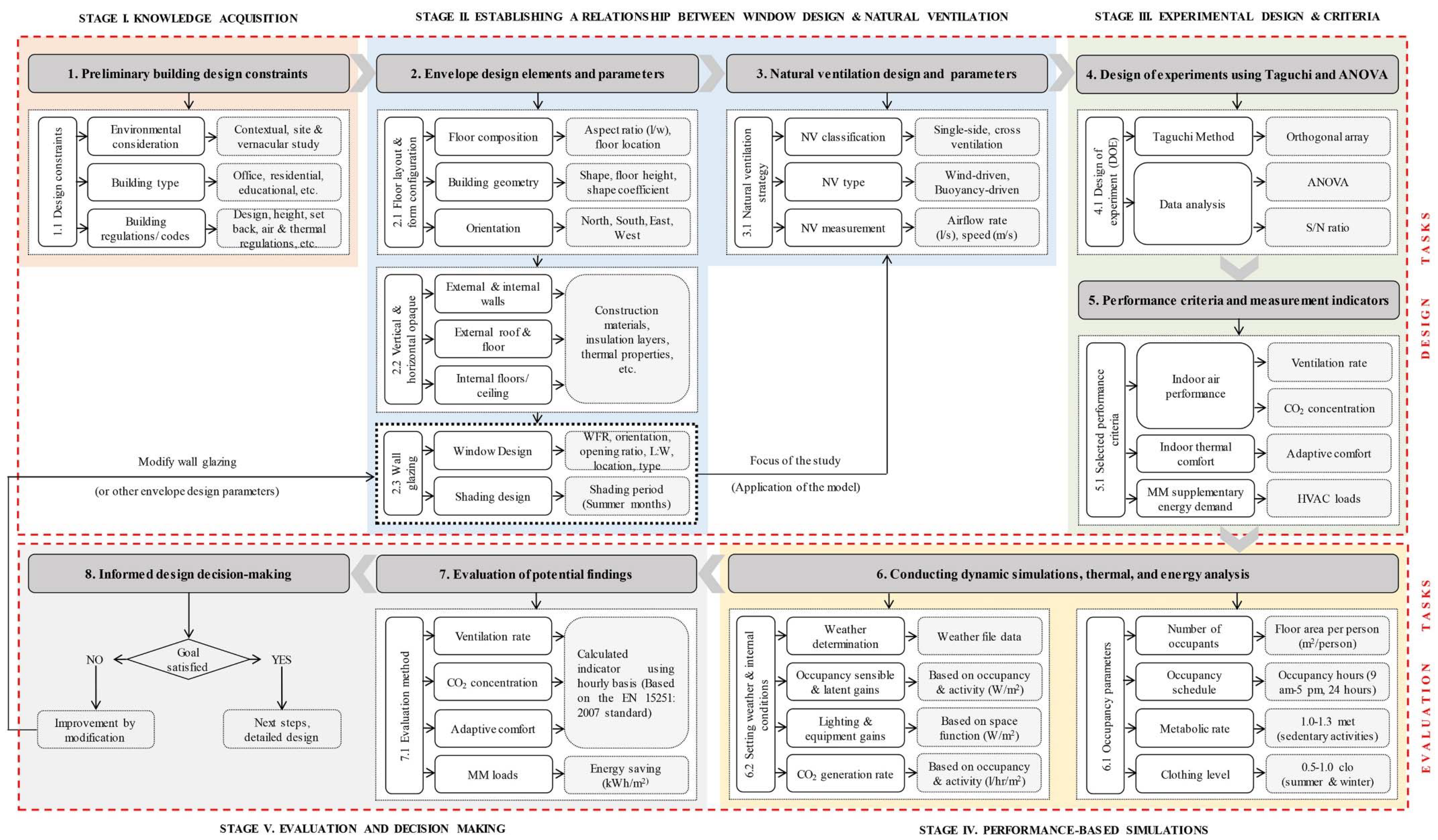

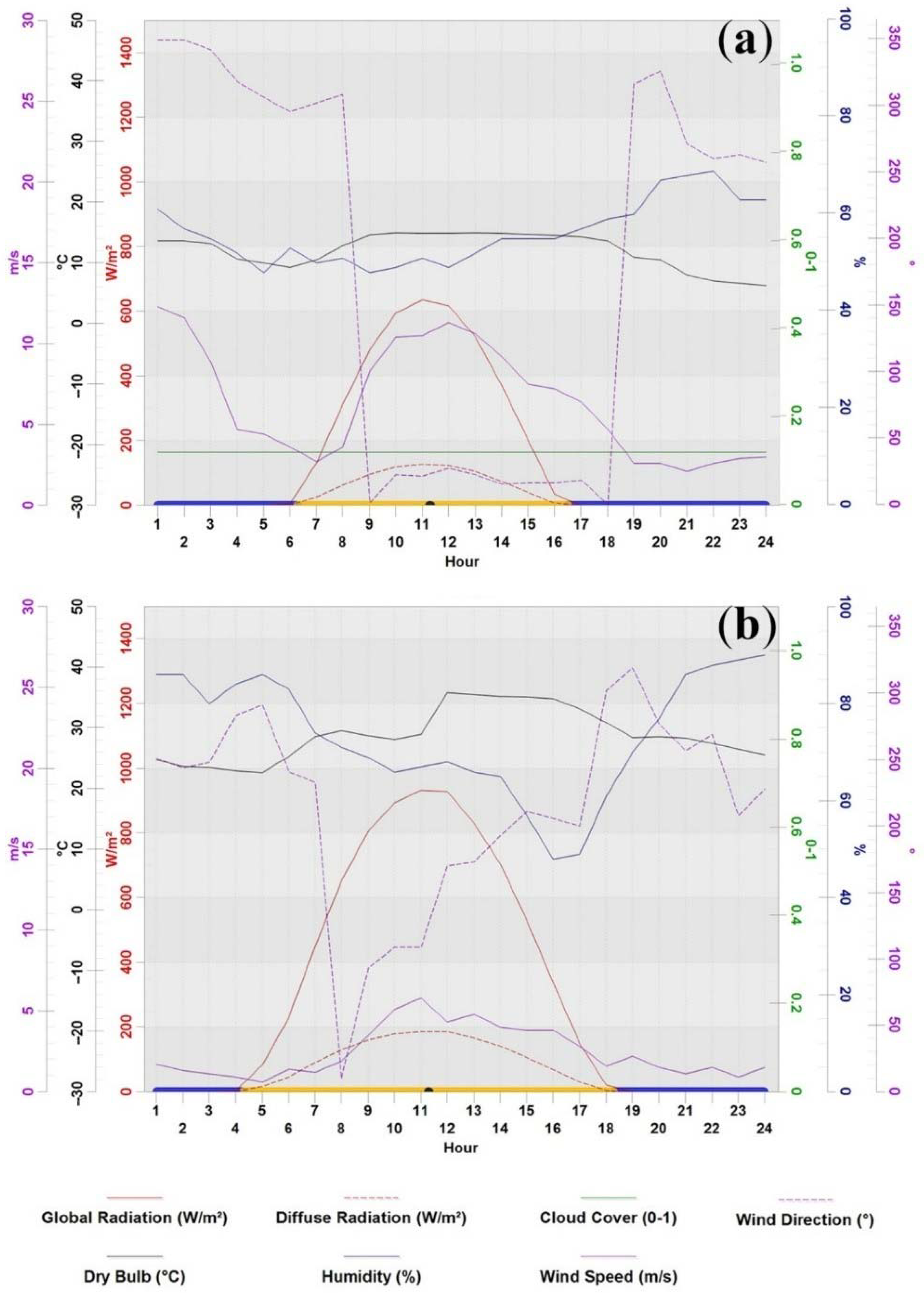
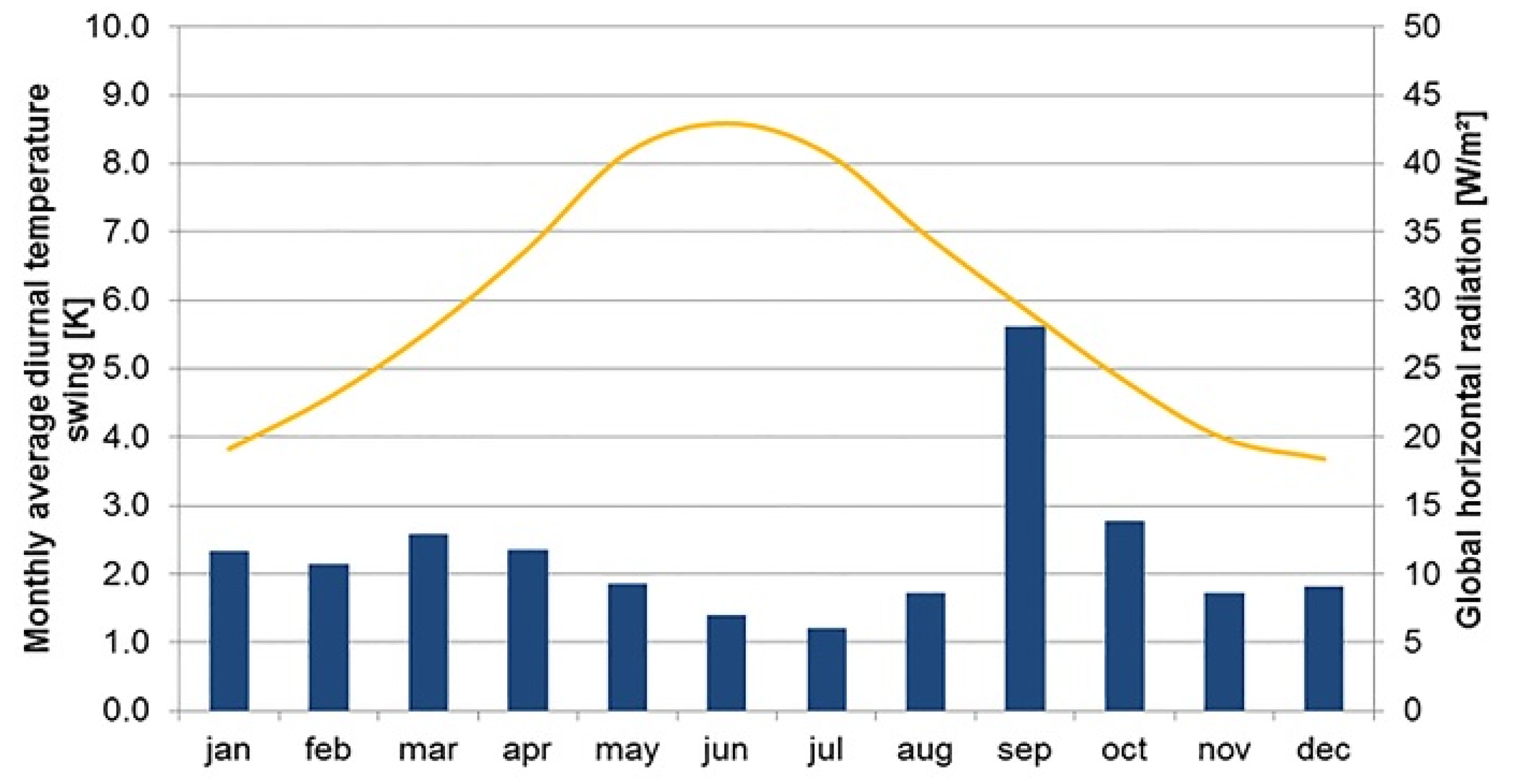
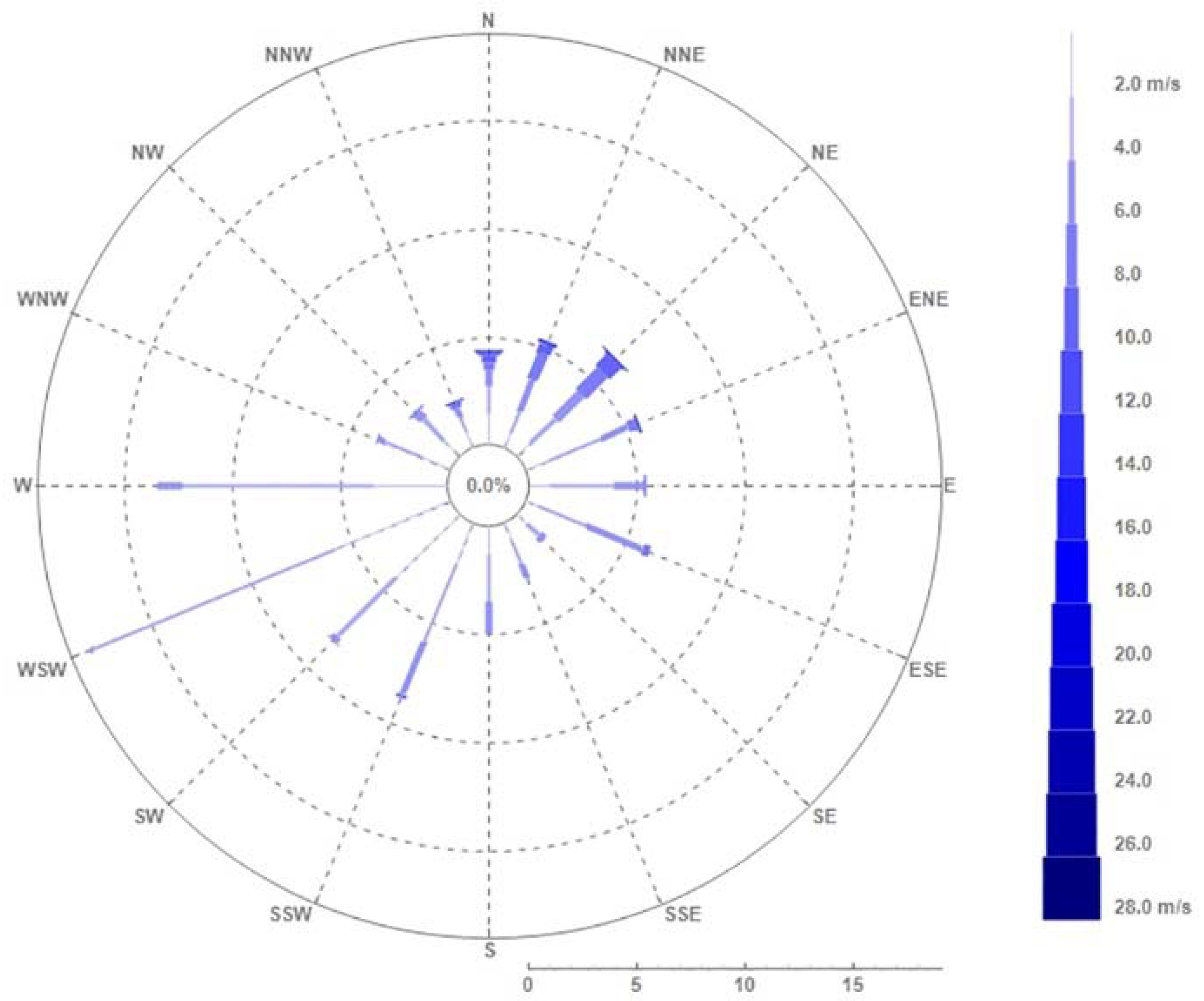

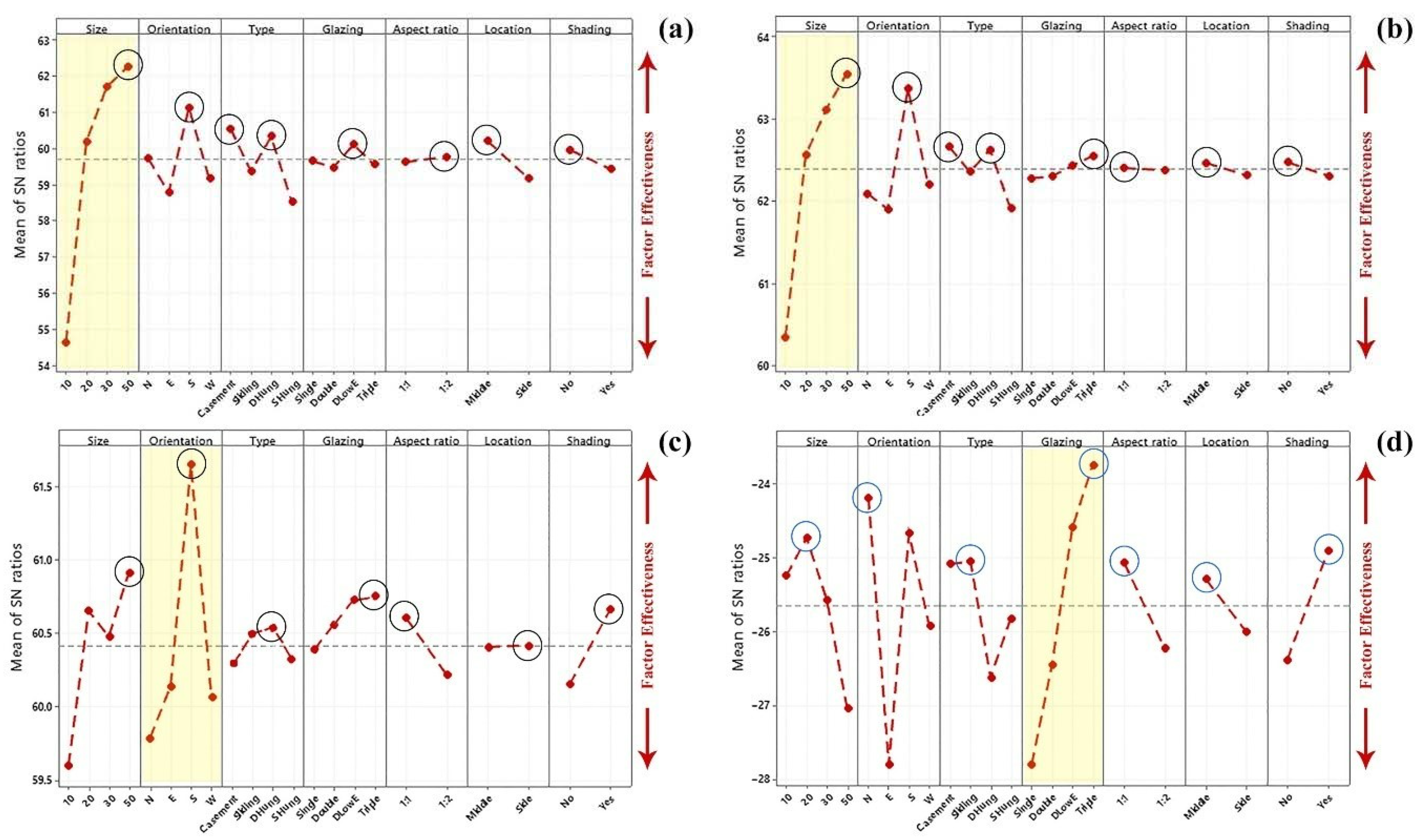

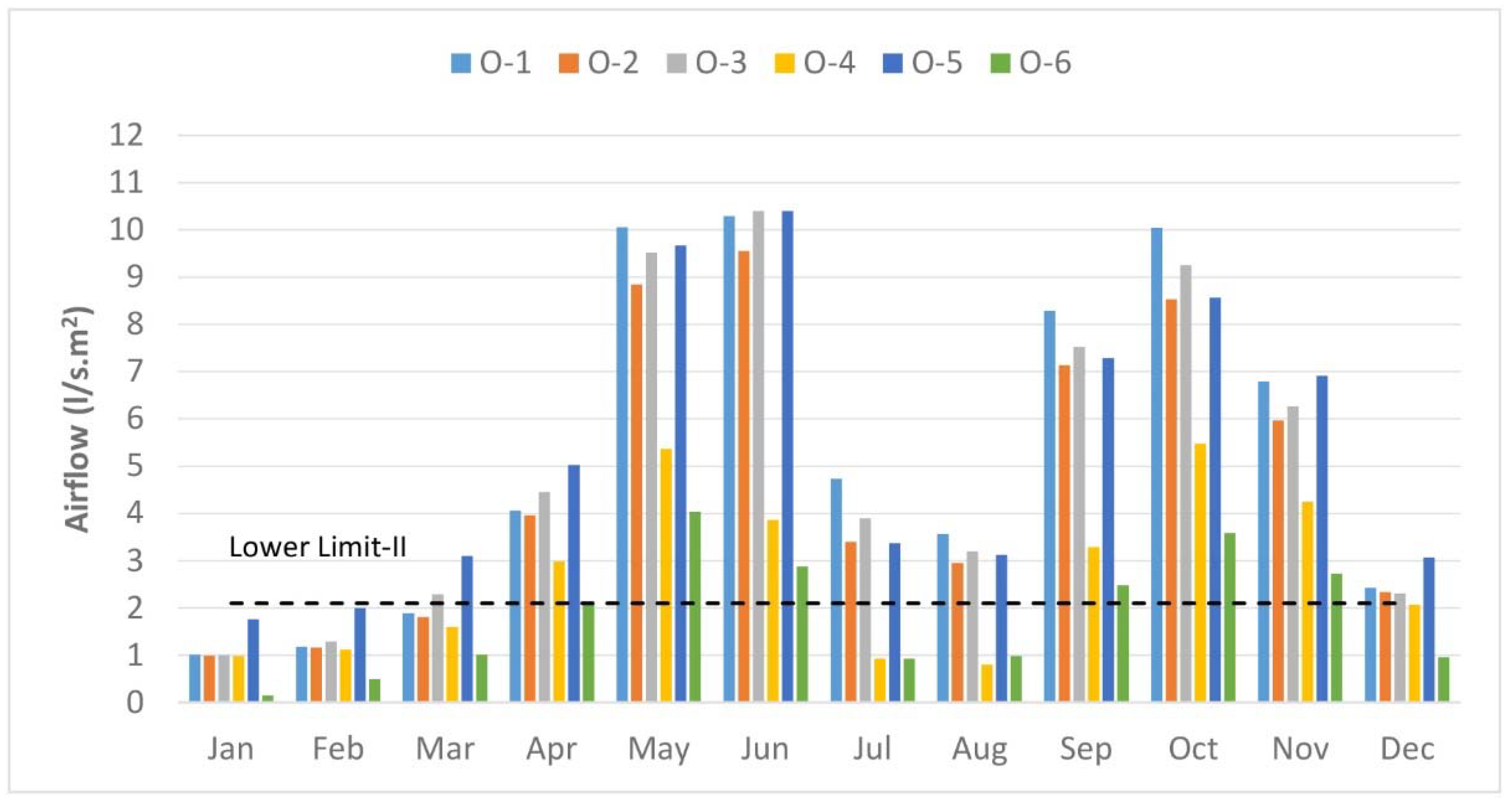
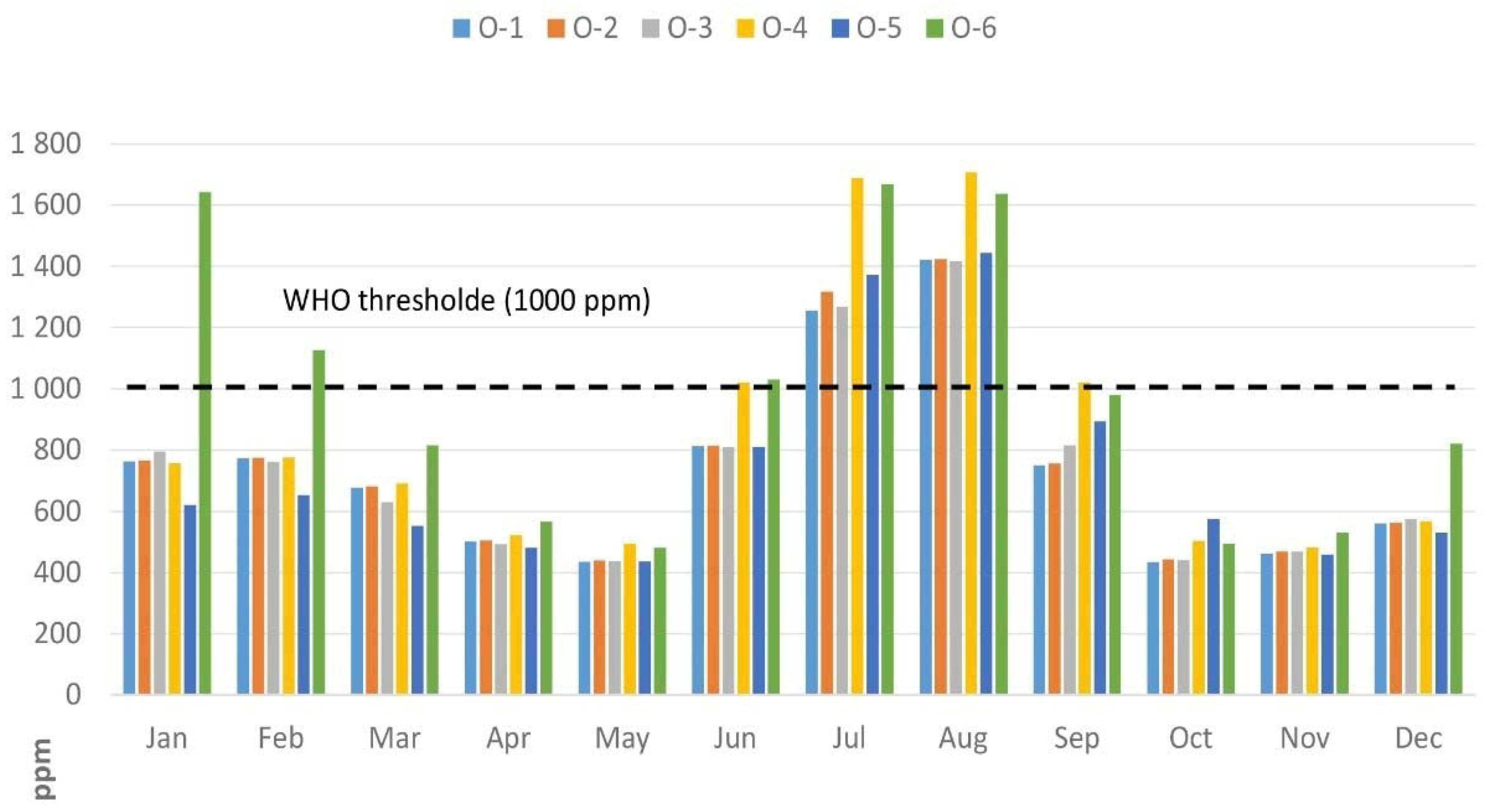
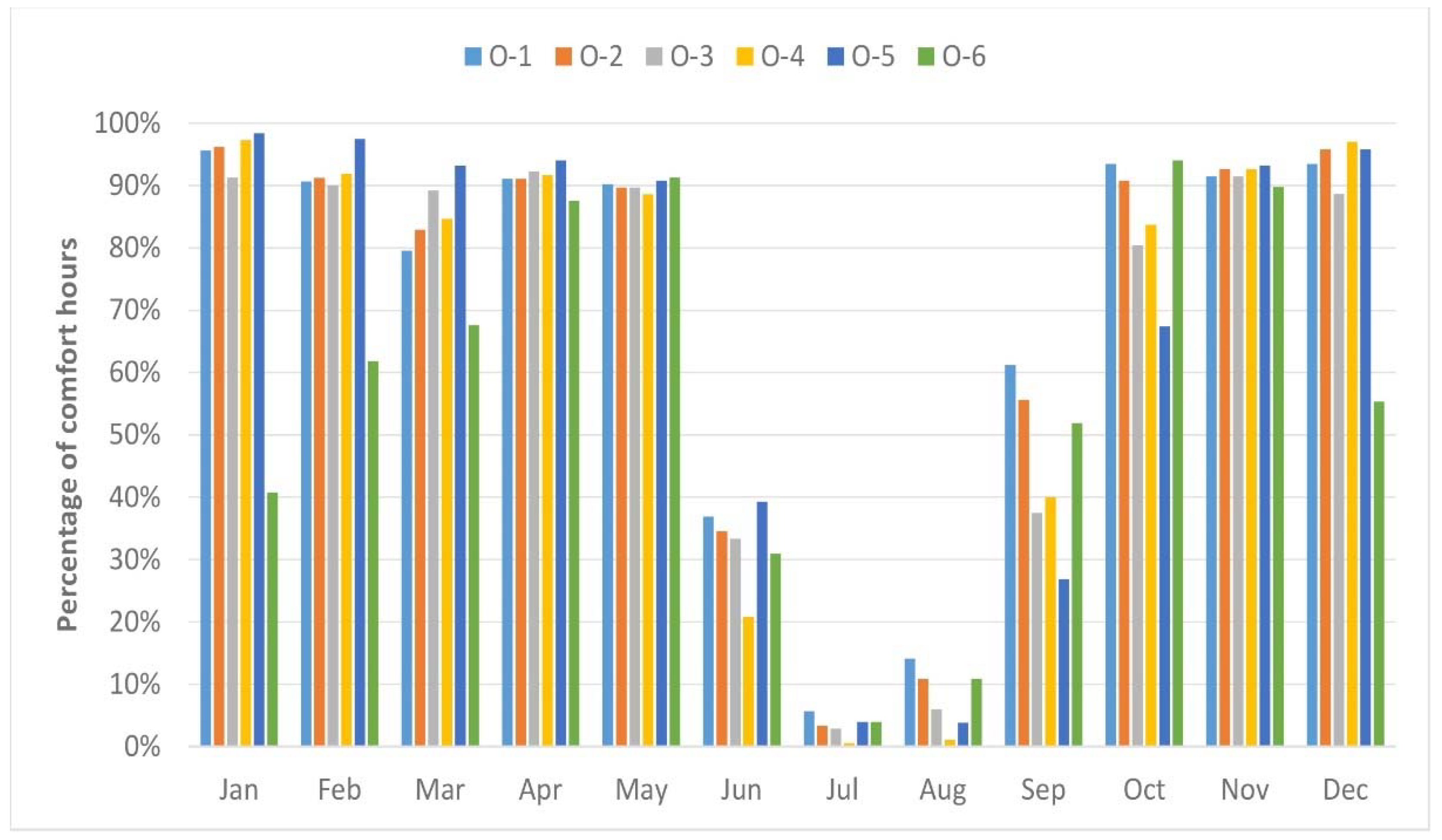
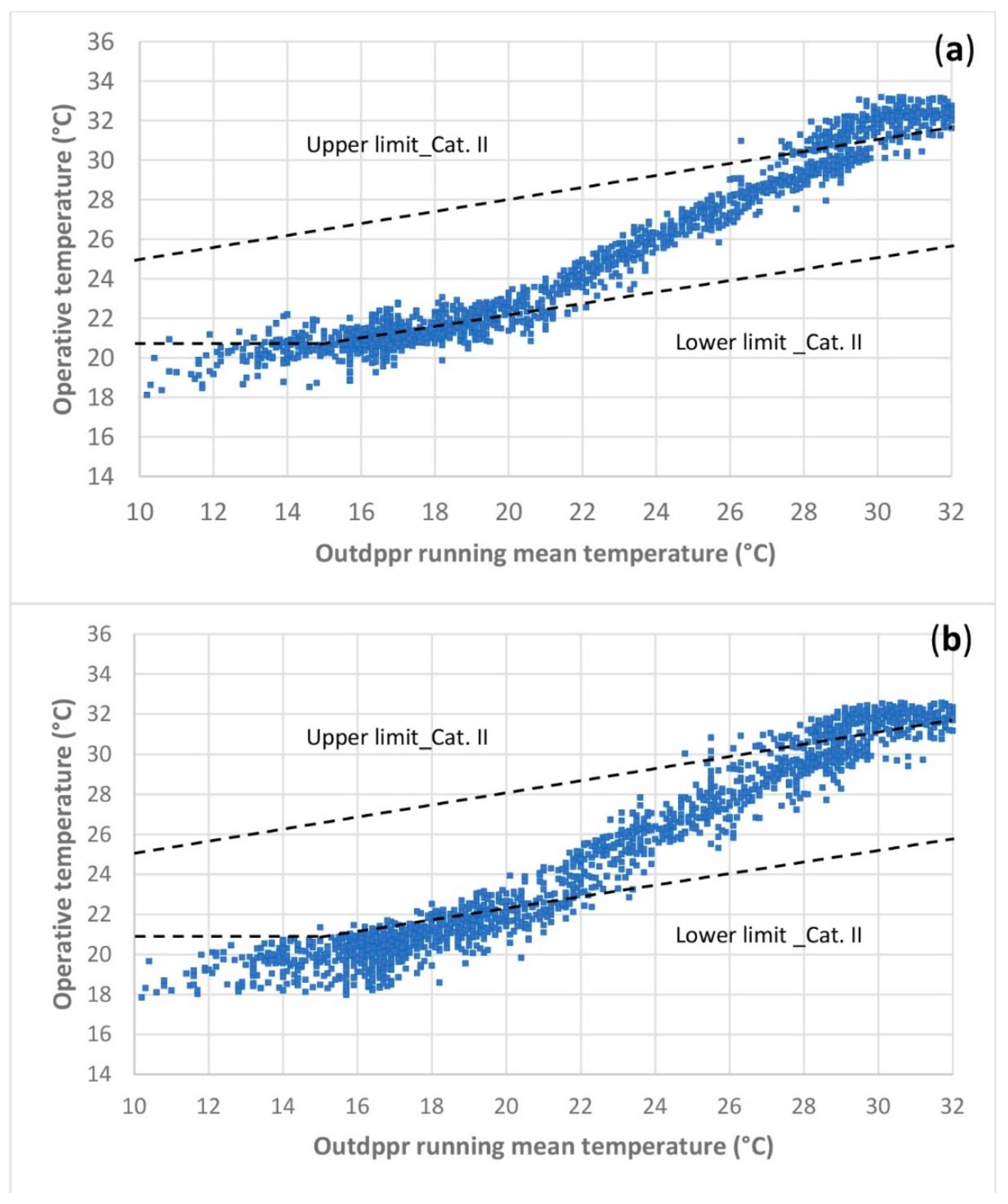
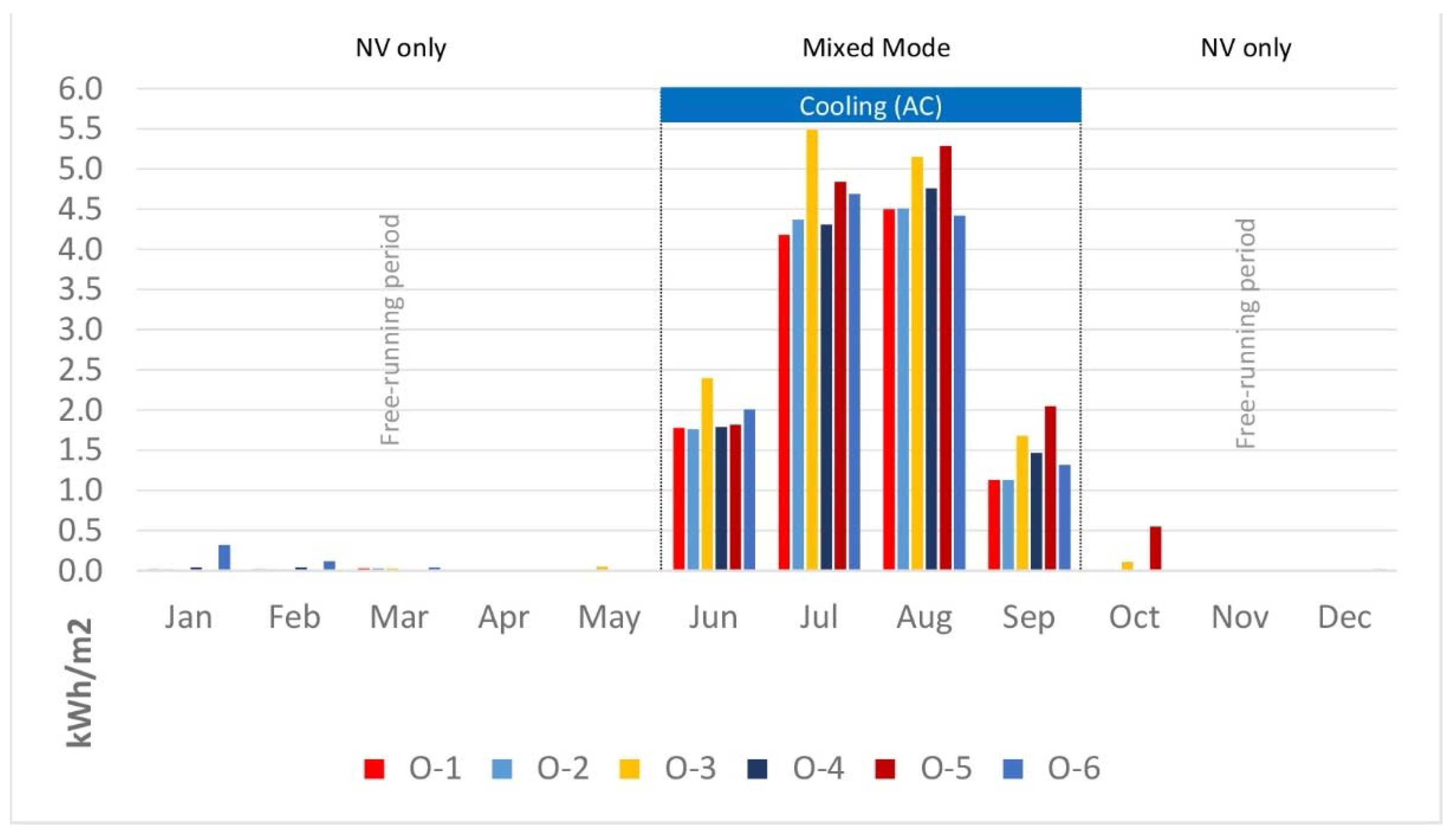
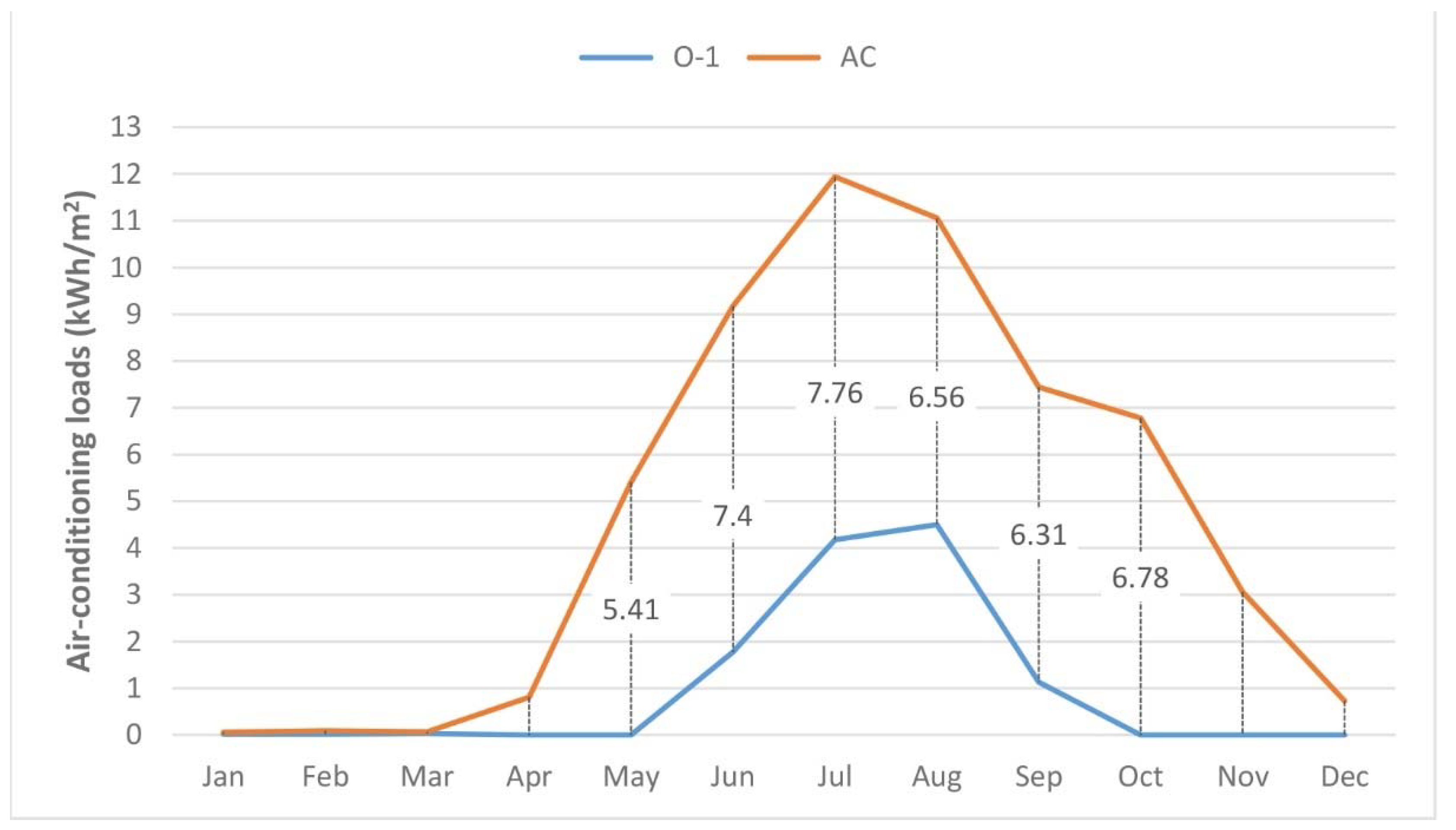
| Category | Evaluation Method | Building Status |
|---|---|---|
| a | Criteria used for energy calculations (design indicators) | New buildings |
| b | Whole-year computer simulations of the indoor environment and energy performance (calculated indicators) | New and existing buildings |
| c | Long-term measurement of selected parameters for the indoor environment (measurements) | Existing buildings |
| d | Subjective responses from occupants (questionnaire) | Existing buildings |
| Standard | CO2 Concentration (ppm) | Method |
|---|---|---|
| WHO | 1000 ppm | Threshold |
| ASHRAE 62.1 | 1100 ppm | Threshold |
| BS EN 15251:2007 | 900 ppm, 1200 ppm | Category II, III |
| Building Type | Category | Occupancy Density (m2/pers) | Ventilation Rate (L/s·m2) | ||
|---|---|---|---|---|---|
| Occupancy (qp) | Building Pollution (qB) | Total (qtot) | |||
| Office | I | 10 10 10 | 1.0 | 2.0 | 3.0 |
| II | 0.7 | 1.4 | 2.1 | ||
| III | 0.4 | 0.8 | 1.2 | ||
| Standard | Adaptive Comfort Formula | Category | Comfort Range (°C) | Expectations | |
|---|---|---|---|---|---|
| Upper | Lower | ||||
|
ASHRAE 55
(American) | 90% | 2.5 | 2.5 | High | |
| 80% | 3.5 | 3.5 | Normal | ||
|
BS EN 15251
(British/European) | I | 2 | 2 | High | |
| II | 3 | 3 | Normal | ||
| III | 4 | 4 | Moderate | ||
| Space Type | Metabolic Rate (met) | Clothing Level (clo) | Heating Temp Range (°C) | Cooling Temp Range (°C) |
|---|---|---|---|---|
| Office (cellular and open-plan) | Sedentary activity (~1.2 met) | Winter (~1.0 clo) Summer (~0.5 clo) | 20.0–24.0 | 23.0–26.0 |
| Construction | Description/Thickness | U-Value (W/m²·°C) |
|---|---|---|
| External wall | Light-weight plaster (25 mm), clay brick wall (250 mm), light-weight plaster (25 mm) | 0.39 |
| Internal wall | Light-weight plaster (25 mm) and clay brick wall (100 mm), light-weight plaster (25 mm) | 0.66 |
| Ceiling/Floor | Ceiling tiles (15 mm), air gap (200 mm), reinforced concrete (150 mm), concrete screed (50 mm), floor wood tiles (10 mm) | 1.0 |
| Ground floor | Floor wood tiles (10 mm), concrete screed (50 mm), reinforced concrete (150 mm), crushed stone (75 mm), soil (1000 mm) | 0.28 |
| Single glass | 4 mm clear float glass | 5.75 (Gv = 0.85) |
| Double glass | 4 mm clear float glass, 10 mm air, 4 mm clear float glass | 2.96 (Gv = 0.75) |
| Double glass, low-E | 6 mm SG planilux clear, 12 mm air, 6 mm SG cool-lite neutral | 1.64 (Gv = 0.35) |
| Triple glass, low-E | 6 mm SG planitherm low-E, 12 mm argon, 6 mm SG cool-lite blue TS 120, 12 mm argon, 6 mm clear float glass | 1.0 (Gv = 0.24) |
| Window frame | 3 mm aluminium, 50 mm air, 3 mm aluminium | 1.450 |
| Level | Parameter (A) | Parameter (B) | Parameter (C) | Parameter (D) | Parameter (E) | Parameter (F) | Parameter (G) |
|---|---|---|---|---|---|---|---|
| Size (WFR) | Orientation | Type | Glazing | Aspect Ratio | Location | Shading | |
| 1 | 10% | North | Casement | Single-pane | 1:1 | Middle | Yes |
| 2 | 20% | East | Sliding | Double glass | 1:2 | Side | No |
| 3 | 30% | South | Double-hung | Double low-E | - | - | - |
| 4 | 50% | West | Single-hung | Triple low-E | - | - | - |
| Simulation Experiments | Factorial Levels | Performance Values | ||||||
|---|---|---|---|---|---|---|---|---|
| Parameter (A) | Parameter (B) | Parameter (C) | Parameter (D) | Parameter (E) | Parameter (F) | Parameter (G) | ||
| 1 | 1 | 1 | 1 | 1 | 1 | 1 | 2 | P1 |
| 2 | 1 | 2 | 2 | 2 | 1 | 2 | 1 | P2 |
| 3 | 1 | 3 | 3 | 3 | 2 | 1 | 1 | P3 |
| 4 | 1 | 4 | 4 | 4 | 2 | 2 | 2 | P4 |
| 5 | 2 | 1 | 2 | 3 | 2 | 2 | 2 | P5 |
| 6 | 2 | 2 | 1 | 4 | 2 | 1 | 1 | P6 |
| 7 | 2 | 3 | 4 | 1 | 1 | 2 | 1 | P7 |
| 8 | 2 | 4 | 3 | 2 | 1 | 1 | 2 | P8 |
| 9 | 3 | 1 | 3 | 4 | 1 | 2 | 1 | P9 |
| 10 | 3 | 2 | 4 | 3 | 1 | 1 | 2 | P10 |
| 11 | 3 | 3 | 1 | 2 | 2 | 2 | 2 | P11 |
| 12 | 3 | 4 | 2 | 1 | 2 | 1 | 1 | P12 |
| 13 | 4 | 1 | 4 | 2 | 2 | 1 | 1 | P13 |
| 14 | 4 | 2 | 3 | 1 | 2 | 2 | 2 | P14 |
| 15 | 4 | 3 | 2 | 4 | 1 | 1 | 2 | P15 |
| 16 | 4 | 4 | 1 | 3 | 1 | 2 | 1 | P16 |
| Building Type | Office | |
|---|---|---|
| Operation time | Time | 09:00–17:00 |
| Hours/day | 8.0 | |
| Days/week | 5.0 | |
| Occupancy | Usage rate (0–1 k) | 1.0 |
| Metabolic rate (met) | 1.2 | |
| Density (m2/pers) | 8.4 | |
| Total (W/m2) | 15.0 | |
| Lighting | Usage rate (0–1 k) | 1.0 |
| Power (W/m2) | 12.0 | |
| Equipment | Usage rate (0–1 k) | 1.0 |
| Power (W/m2) | 18.0 | |
| Design Cases | Design Parameters | Measured Performance Criteria | |||||||||
|---|---|---|---|---|---|---|---|---|---|---|---|
| Size (WFR) | Window Orientation | Window Type | Glazing Property | Aspect Ratio | Window Location | External Shading | VR (h) | CO2 (h) | TC (h) | AC Load (kWh/m2) | |
| 1 | 10 | N | Casement | Single g. | 1:1 | Middle | No | 644 | 1044 | 923 | 18.1 |
| 2 | 10 | E | Sliding | Double g. | 1:1 | Side | Yes | 412 | 954 | 894 | 21.5 |
| 3 | 10 | S | D-hung | D. low-E | 1:2 | Middle | Yes | 745 | 1200 | 1034 | 15.3 |
| 4 | 10 | W | S-hung | Triple g. | 1:2 | Side | No | 429 | 982 | 976 | 18.8 |
| 5 | 20 | N | Sliding | D. low-E | 1:2 | Side | No | 1016 | 1298 | 987 | 14.6 |
| 6 | 20 | E | Casement | Triple g. | 1:2 | Middle | Yes | 1037 | 1331 | 1020 | 15.7 |
| 7 | 20 | S | S-hung | Single g. | 1:1 | Side | Yes | 952 | 1382 | 1251 | 18.1 |
| 8 | 20 | W | D-hung | Double g. | 1:1 | Middle | No | 1094 | 1362 | 1072 | 21.4 |
| 9 | 30 | N | D-hung | Triple g. | 1:1 | Side | Yes | 1171 | 1422 | 1020 | 12.9 |
| 10 | 30 | E | S-hung | D. low-E | 1:1 | Middle | No | 1090 | 1312 | 1076 | 21.5 |
| 11 | 30 | S | Casement | Double g. | 1:2 | Side | No | 1514 | 1634 | 1189 | 21.2 |
| 12 | 30 | W | Sliding | Single g. | 1:2 | Middle | Yes | 1138 | 1373 | 954 | 22.2 |
| 13 | 50 | N | S-hung | Double g. | 1:2 | Middle | Yes | 1151 | 1359 | 976 | 20.1 |
| 14 | 50 | E | D-hung | Single g. | 1:2 | Side | No | 1224 | 1442 | 1086 | 50.1 |
| 15 | 50 | S | Sliding | Triple g. | 1:1 | Middle | No | 1573 | 1740 | 1391 | 14.7 |
| 16 | 50 | W | Casement | D. low-E | 1:1 | Side | Yes | 1277 | 1498 | 1033 | 17.3 |
| Factor | DF | SSV | MSV | Effect | Rank |
|---|---|---|---|---|---|
| Size | 3 | 1355593 | 451864 | 81.59% | 1 |
| Orientation | 3 | 155118 | 51706 | 9.33% | 2 |
| Type | 3 | 96306 | 32102 | 5.80% | 3 |
| Glazing | 3 | 9242 | 3081 | 0.56% | 6 |
| Aspect ratio | 1 | 105 | 105 | 0.01% | 7 |
| Location | 1 | 14221 | 14221 | 0.86% | 5 |
| Shading | 1 | 30713 | 30713 | 1.85% | 4 |
| Residual error | 0 | ||||
| Total | 15 | 1661296 | 100% |
| Factor | DF | SSV | MSV | Effect | Rank |
|---|---|---|---|---|---|
| Size | 3 | 498977 | 166326 | 73.54% | 1 |
| Orientation | 3 | 133147 | 44382 | 19.62% | 2 |
| Type | 3 | 32188 | 10729 | 4.74% | 3 |
| Glazing | 3 | 7457 | 2486 | 1.10% | 4 |
| Aspect ratio | 1 | 564 | 564 | 0.08% | 7 |
| Location | 1 | 743 | 743 | 0.11% | 6 |
| Shading | 1 | 5439 | 5439 | 0.80% | 5 |
| Residual error | 0 | ||||
| Total | 15 | 678515 | 100% |
| Factor | DF | SSV | MSV | Effect | Rank |
|---|---|---|---|---|---|
| Size | 3 | 59416 | 19805.4 | 24.25% | 2 |
| Orientation | 3 | 142395 | 47465.1 | 58.12% | 1 |
| Type | 3 | 1651 | 550.4 | 0.67 % | 6 |
| Glazing | 3 | 12756 | 4252.1 | 5.21% | 4 |
| Aspect ratio | 1 | 11990 | 11990 | 4.89% | 5 |
| Location | 1 | 6 | 6 | 0.00% | 7 |
| Shading | 1 | 16770 | 16770 | 6.85% | 3 |
| Residual error | 0 | ||||
| Total | 15 | 244986 | 100% |
| Factor | DF | SSV | MSV | Effect | Rank |
|---|---|---|---|---|---|
| Size | 3 | 159.83 | 53.27 | 14.79% | 3 |
| Orientation | 3 | 286.47 | 95.49 | 26.52% | 2 |
| Type | 3 | 123.61 | 41.20 | 11.44% | 4 |
| Glazing | 3 | 317.15 | 105.71 | 29.36% | 1 |
| Aspect ratio | 1 | 65.65 | 65.65 | 6.08% | 6 |
| Location | 1 | 40.23 | 40.23 | 3.72% | 7 |
| Shading | 1 | 87.38 | 87.38 | 8.09% | 5 |
| Residual error | 0 | ||||
| Total | 15 | 1080.32 | 100% |
| Trade-off Cases | Design Parameters | Measured Performance Criteria | |||||||||
|---|---|---|---|---|---|---|---|---|---|---|---|
| Size (WFR) | Window Orientation | Window Type | Glazing Property | Aspect Ratio | Window Location | External Shading | VR (h) | CO2 (h) | TC (h) | AC Load (kWh/m2) | |
| 1 | 50 | S | D-hung | D. low-E | 1:1 | Middle | Yes | 1511 | 1749 | 1466 | 11.66 |
| 2 | 50 | S | Sliding | D. low-E | 1:1 | Middle | Yes | 1502 | 1746 | 1451 | 11.85 |
| 3 | 50 | S | Casement | D. low-E | 1:1 | Middle | Yes | 1501 | 1748 | 1379 | 12.41 |
| 4 | 50 | S | S-hung | D. low-E | 1:1 | Middle | Yes | 1396 | 1632 | 1374 | 14.96 |
| 5 | 50 | S | Casement | Triple g. | 1:1 | Middle | No | 1586 | 1751 | 1398 | 14.56 |
| 6 | 20 | S | D-hung | D. low-E | 1:1 | Middle | Yes | 1125 | 1441 | 1194 | 12.94 |
Publisher’s Note: MDPI stays neutral with regard to jurisdictional claims in published maps and institutional affiliations. |
© 2022 by the authors. Licensee MDPI, Basel, Switzerland. This article is an open access article distributed under the terms and conditions of the Creative Commons Attribution (CC BY) license (https://creativecommons.org/licenses/by/4.0/).
Share and Cite
Abdullah, H.K.; Alibaba, H.Z. A Performance-Based Window Design and Evaluation Model for Naturally Ventilated Offices. Buildings 2022, 12, 1141. https://doi.org/10.3390/buildings12081141
Abdullah HK, Alibaba HZ. A Performance-Based Window Design and Evaluation Model for Naturally Ventilated Offices. Buildings. 2022; 12(8):1141. https://doi.org/10.3390/buildings12081141
Chicago/Turabian StyleAbdullah, Hardi K., and Halil Z. Alibaba. 2022. "A Performance-Based Window Design and Evaluation Model for Naturally Ventilated Offices" Buildings 12, no. 8: 1141. https://doi.org/10.3390/buildings12081141






